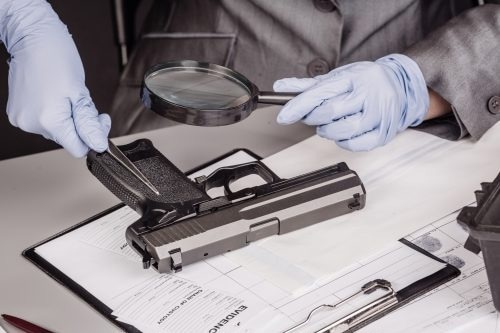A piece of evidence goes on a significant journey throughout its existence. Consider a gun recovered at a crime scene. Following the completion of the initial on-site inquiry, the gun may be transported to a property and evidence storage facility.

Image Credit: LabVantage Solutions
The next week, it may be relocated to the laboratory, where it is first swabbed for DNA before being forwarded to Firearms for additional testing.
After testing, the weapon is returned to the property and evidence facility, where it will stay until it is either submitted as evidence in court or dispositioned by property employees.
Dispositioning could include returning it to its owner, destroying it, converting it to police use, or some other resolution.

Image Credit: LabVantage Solutions
In this case, if the law enforcement organization investigating the incident employs several systems for different places or duties, the journey will be fraught with complications.
The greater the number of handoffs, interactions, communications, or exchanges — whether between people at different stages of the investigation team or between the various systems they use — the greater the risk of roadblocks, or other errors that could seriously impede or compromise the investigation. Furthermore, obvious links between multiple items of evidence can be overlooked or confused.
This article presents the management concerns as well as what having LIMS help in the forensics investigations will entail.
Efficient forensic investigation management
Most law enforcement agencies manage forensic investigations using multiple systems. While this method is widely used, it introduces unnecessary complications to forensic work. One software application may be employed at a crime scene, another at a laboratory, and a third in a property and evidence storage facility.
The most visible and troublesome drawbacks are the increased chances of errors and delays, particularly when evidence must be “passed over” across systems. Furthermore, there are inefficiencies in terms of time and money involved in maintaining the interfaces themselves, as well as managing maintenance and support contracts with different vendors.
Benefits of a unified LIMS
If every stage of the inquiry is integrated into a single complete Laboratory Information Management System (LIMS), forensics teams can gain considerable advantages. As there is no need to move between multiple siloed applications, users can significantly reduce system risks.
Managing costs
Integrating all functions into a single system from a single vendor minimizes the need for various contracts and support plans, as well as lowers the total cost of ownership. At the same time, because users and administrators only need to become skilled with one system, the learning curve becomes considerably more manageable.
Reducing risk
However, the greatest advantage is risk minimization. A complete system eliminates the need to re-enter data that has already been entered elsewhere, such as victim, suspect, evidence, or other facts. This removes the need for duplicate data entry, resulting in far fewer human errors.
Ease of use and compliance
A LIMS built for forensics applications should ideally be intuitive for end-users at all stages of the inquiry, with strong interface capabilities between different members of the team as well as other key systems. Another advantage is browser independence, which allows team members to work on any device without limiting future hardware or software changes. Moreover, a forensic LIMS must support the most recent legislative and technological standards, evolving over time to ensure compliance.
What does a forensic inquiry look like with such a robust framework in place?
Imagine a unified forensic workflow
Crime scene investigators might use a complete system to document all relevant information on the scene, like weather conditions, hazards, preservation and protection procedures, images, videos, evidence obtained, and tactics used. They can record the scene narrative and keep track of who entered and left the scene.

Image Credit: LabVantage Solutions
When evidence is gathered, an electronic chain of custody is established. When the evidence arrives at the lab or property, this simplifies the receiving process. As all of the data is already in the LIMS, data may be quickly obtained by scanning a barcode. They can be safely stored and quickly accessed once they are in the LIMS.
As evidence travels between lab units and property, all stakeholders may easily identify the present custodian and location by following the chain of custody. Furthermore, because all evidence is kept in a single database, lab employees can determine what other things may be related to the case and request them from storage as needed.
Furthermore, law enforcement agencies frequently require connections between the LIMS and other systems, such as the agency’s Records Management System (RMS) or the Criminal Justice Information System (CJIS). In such circumstances, organizations benefit substantially from selecting a more sophisticated, enterprise-level LIMS with fewer needless interfaces.
Forensics laboratories rely largely on both the availability of collected data and the integrity of samples and data. This quest for greater efficiency and data integrity across the evidence lifecycle is a driving force behind the industry’s present digital transformation.
About LabVantage Solutions
LabVantage Solutions, Inc. is the leading global laboratory informatics provider. Our industry-leading LIMS platform, including ELN, LES, and SDMS, and world-class services are the result of nearly 40 years of experience in laboratory informatics. LabVantage offers a comprehensive portfolio of products and services that enable companies to innovate faster in the R&D cycle, improve manufactured product quality, achieve accurate recordkeeping and data integrity, and comply with regulatory requirements.
LabVantage is a highly configurable, web-based LIMS platform that powers hundreds of laboratories globally, large and small. Built on a platform that is widely recognized as the best in the industry, LabVantage can support hundreds of concurrent users as well as interface with instruments and other enterprise systems. It is the best choice for industries ranging from pharmaceuticals and consumer goods to molecular diagnostics and bio banking. LabVantage domain experts advise customers on best practices and maximize their ROIs by optimizing LIMS implementation with a rapid and successful deployment.
Sponsored Content Policy: News-Medical.net publishes articles and related content that may be derived from sources where we have existing commercial relationships, provided such content adds value to the core editorial ethos of News-Medical.Net which is to educate and inform site visitors interested in medical research, science, medical devices and treatments.